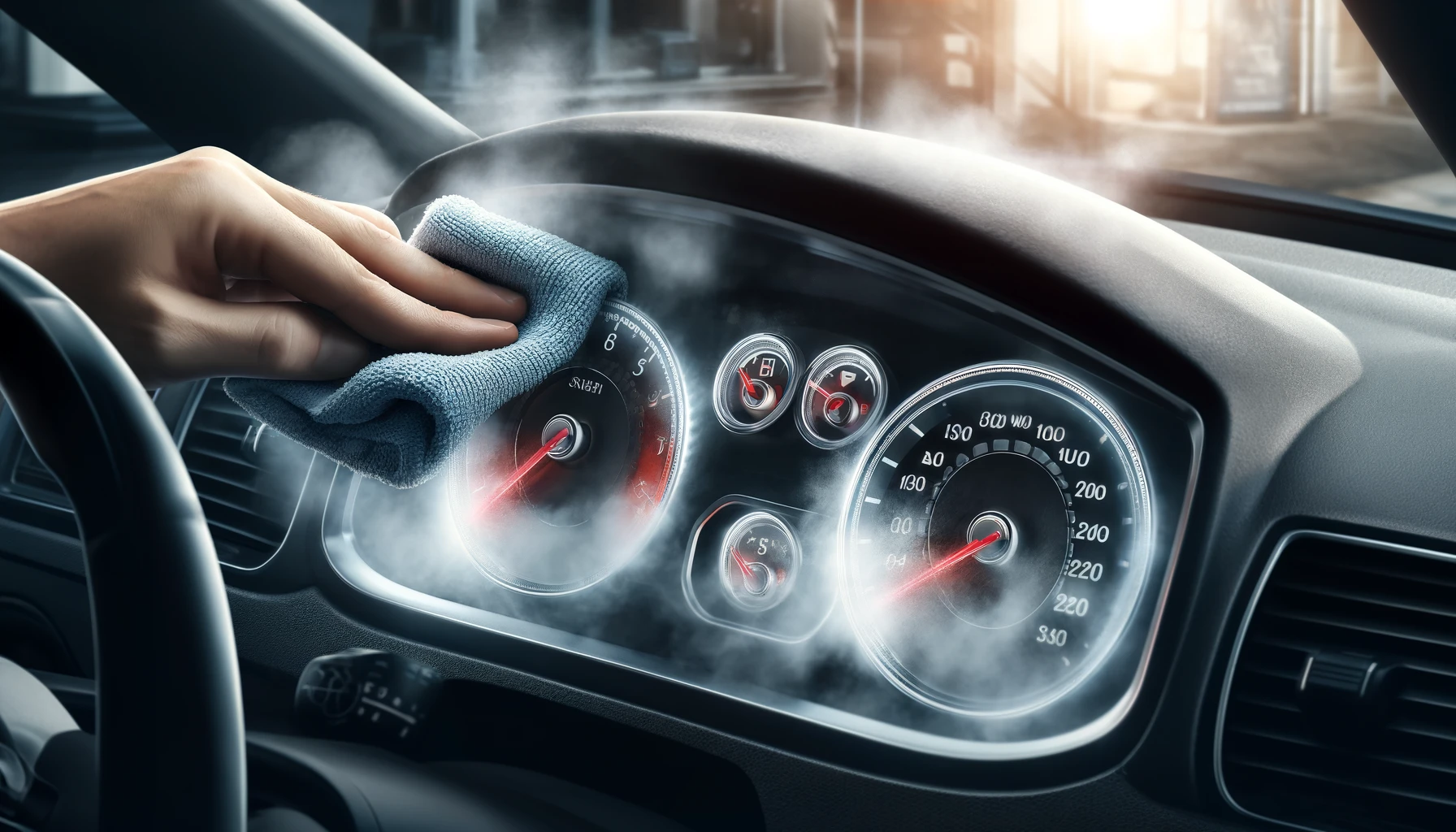- Introduction: Why Do Gauges Fog Up?
- Common Causes of Fogged-Up Gauges
- Can You Fix Gauges That Fog Up?
- Step-by-Step Guide: How to Fix Fogged-Up Gauges
- Preventing Gauges from Fogging Up Again
- What to Do If Fogging Persists?
- DIY vs. Professional Fixes: Which One to Choose?
- The Impact of Fogged Gauges on Performance and Safety
- FAQs on Fogged-Up Gauges
- Conclusion: Keeping Your Gauges Clear for Optimal Performance
Introduction: Why Do Gauges Fog Up?
Gauges fog up when moisture builds up inside the gauge or on its surface. This happens because of temperature changes, humidity, or poor sealing around the gauge. If the air around the gauge is warmer or cooler than the gauge itself, condensation forms, making it hard to read. This can occur in vehicles, boats, or any equipment that uses gauges.
Addressing fogged-up gauges is important for several reasons. First, visibility is reduced, making it harder to see the gauge readings. In a vehicle, for example, not being able to read the speedometer or fuel gauge can lead to unsafe driving conditions. It also affects the functionality of the gauge. Over time, repeated fogging can damage the internal parts, causing long-term issues.
So, can you fix gauges that fog up? The answer is yes, and it’s something you should take care of quickly to avoid further problems. Fixing the fog will help ensure your safety and keep the equipment working properly.
This article will guide you through the causes of fogged gauges, how to fix them, and how to prevent it from happening again.
Common Causes of Fogged-Up Gauges
Fogged-up gauges are a common issue, and they happen due to several factors. Understanding these causes can help you prevent the problem in the future. Let’s look at the most common reasons:
Moisture Accumulation
Moisture is the primary reason gauges fog up. Over time, small amounts of water can get inside the gauge, especially if it is not sealed properly. When this moisture comes into contact with the cool surface of the gauge, it forms fog or condensation.
Temperature Fluctuations
Rapid changes in temperature are another major cause of fogged-up gauges. For example, if you move from a cold environment to a warmer one, or if your vehicle heats up after being parked outside on a cold day, the sudden temperature difference can cause condensation inside the gauge.
Poor Seal on Gauges
Gauges that are not sealed tightly allow moisture and air to seep in. This is one of the most preventable causes of fogging. If the seal on your gauge is cracked or worn out, it can let in moisture, which leads to fogging.
Humid Environments
If you live or work in a place with high humidity, like near a coast or in a tropical climate, your gauges are more likely to fog up. The air around the gauge contains more moisture, which can seep into the gauge, causing fogging even without temperature changes.
Condensation Due to Pressure Differences
Sometimes, pressure differences between the inside and outside of the gauge can cause fogging. This is especially common in boats and airplanes, where gauges are exposed to different pressures during operation. When air pressure changes, it can create condensation inside the gauge.
Understanding these causes is key to finding a solution. In the next sections, we will explore how to fix these fogged-up gauges and prevent the problem from happening again. By knowing the common causes, you can take steps to avoid this issue in the future.
Can You Fix Gauges That Fog Up?
Yes, you can fix fogged-up gauges, and it’s often simpler than it might seem. Fogged gauges are typically caused by moisture, and there are several effective ways to address this issue.
Here are the main methods to fix fogged-up gauges:
- Remove Moisture Inside the Gauge – You can dry out the moisture using methods like placing silica gel packets near the gauge or using a dehumidifier.
- Re-Seal the Gauge – If the gauge seal is damaged, replacing it or using a silicone sealant can prevent future moisture buildup.
- Ventilate the Area Around the Gauges – Ensuring good airflow can reduce condensation.
- Use Anti-Fog Products – Applying an anti-fog solution to the surface of the gauge can help prevent fogging.
In the following sections, we will go over each of these methods in detail so you can easily fix fogged-up gauges and prevent them from fogging again.
Step-by-Step Guide: How to Fix Fogged-Up Gauges
If you’re dealing with fogged-up gauges, follow these simple steps to fix the problem and keep your gauges clear. Each step is easy to do and will help solve the issue quickly.
Step 1: Inspect the Gauges for Damage or Leaks
Before starting any repairs, take a close look at your gauges. Check for any cracks or gaps in the seal around the gauge. These small openings can let in moisture, which leads to fogging. If you notice any damage or worn-out seals, that could be the source of the problem.
Step 2: Remove Moisture from the Gauges
Once you’ve inspected the gauges, the next step is to get rid of the moisture causing the fogging. Here are a couple of methods:
- Use a Silica Gel Pack or Desiccant: Place a silica gel pack (or another type of desiccant) near the gauge. These packs absorb moisture and can help dry out the inside of the gauge.
- Air-Drying Techniques: Sometimes, simply allowing the gauge to air out can work. If possible, open up the panel where the gauge is located and let the air flow naturally.
Step 3: Re-Seal the Gauges
If you found any leaks or cracks in the first step, now is the time to fix them. Apply silicone sealant around the edges of the gauge to close any gaps. If the seal is too worn out, you may need to replace it entirely. This will prevent future moisture from getting inside and fogging up the gauge again.
Step 4: Use a Dehumidifier in the Environment
If you live or work in a very humid environment, it’s a good idea to use a dehumidifier. Place the vehicle or equipment in a space with lower humidity, or use a portable dehumidifier to reduce moisture in the air. This helps keep the inside of the gauge dry.
Step 5: Ventilation Adjustments
Good airflow is key to preventing condensation. Make sure there is proper ventilation around the gauges. For example, check the air vents in your vehicle or the space where the equipment is located. This will help regulate the temperature and reduce the chances of fogging.
Preventing Gauges from Fogging Up Again
Once you’ve fixed your fogged-up gauges, it’s important to take steps to prevent the problem from happening again. By following these simple tips, you can keep your gauges clear and functional for the long term.
Regular Maintenance
One of the easiest ways to avoid fogged-up gauges is through regular maintenance. Make it a habit to check the seals around your gauges to ensure they are in good condition. If you notice any cracks, wear, or damage, replace the seal immediately. This will prevent moisture from seeping in and causing fogging.
Use Protective Gauge Covers
Protective covers are a great way to shield your gauges from moisture. Invest in moisture-resistant covers that are designed to prevent condensation from forming. These covers help to protect the surface of the gauges from temperature changes and humidity, which are the main causes of fogging.
Control Moisture in the Surrounding Environment
If you are in a humid environment, controlling the moisture in the area can make a big difference. Here are a few ways to reduce ambient humidity:
- Use a Dehumidifier: A dehumidifier can help lower the moisture levels in the air, especially in enclosed spaces like vehicles, boats, or garages.
- Improve Ventilation: Make sure there is good airflow around the gauges to prevent the buildup of moisture. Open windows or use fans if needed to keep the air moving.
Temperature Control
Rapid temperature changes around the gauges are one of the main causes of fogging. To prevent this:
- Avoid Extreme Temperature Fluctuations: Try to park your vehicle or store your equipment in places where temperatures remain relatively constant. Avoid moving from cold to warm environments quickly, as this can cause condensation to form on the gauges.
By following these prevention tips, you can reduce the likelihood of fogging and keep your gauges working properly for years to come. Regular maintenance and environmental control are key to keeping your gauges fog-free.
What to Do If Fogging Persists?
If you’ve tried the steps to fix fogged-up gauges but the problem keeps coming back, it may be time to consider other options. Persistent fogging can be a sign of deeper issues that need more attention. Here’s what to do if the fogging won’t go away.
Consider Professional Gauge Repair
If the fogging issue persists despite your efforts, it might be time to seek professional help. A technician can disassemble the gauge and inspect it for internal problems that are not visible from the outside. They can also ensure that the seals are properly applied and that no internal moisture is trapped.
Professional gauge repair is often the best option if the gauge is expensive or critical to the operation of your vehicle or equipment. They can identify issues that might be difficult to fix on your own, ensuring the gauge works as intended.
When to Replace the Gauge Entirely
In some cases, the best solution is to replace the gauge completely. This is especially true if the gauge is old, badly damaged, or continues to fog up despite repairs. Over time, seals and other internal parts wear down, allowing moisture to get inside repeatedly. Replacing the gauge can save you time and frustration, especially if fogging continues to affect performance or visibility.
If the fogging is causing safety concerns or the gauge readings are becoming hard to see, replacement might be the safest option.
Possible Electrical Issues Causing Repeated Fogging
Another reason your gauges might keep fogging up is due to electrical issues. Gauges that are part of an electrical system, like those in cars or boats, can be affected by faulty wiring or improper connections. Electrical issues can lead to overheating or incorrect readings, which in turn may cause condensation to build up.
If you suspect electrical problems, it’s important to have a professional check the wiring and connections. Fixing any underlying electrical issues can prevent further fogging and ensure the gauges are functioning correctly.
DIY vs. Professional Fixes: Which One to Choose?
When dealing with fogged-up gauges, you may wonder whether you can fix the issue yourself or if it’s time to call in a professional. Here’s a simple guide to help you decide between DIY and professional fixes.
When You Can Fix It Yourself
If the fogging issue seems minor and the cause is something simple, like moisture buildup or a worn-out seal, you can usually handle the fix on your own. Here are some situations where a DIY fix is enough:
- Drying the Gauge: Using a silica gel pack or letting the gauge air out is a quick and easy method that most people can do.
- Re-Sealing the Gauge: If you notice cracks or gaps in the seal, applying silicone sealant or replacing the seal is a straightforward fix. This can help prevent future fogging.
These simple fixes are ideal for those who enjoy doing small repairs themselves and want to save money. Just make sure you follow the steps carefully to avoid damaging the gauge further.
When to Seek Professional Help
While many fogging issues can be solved with basic DIY methods, there are times when it’s best to seek professional help. Here are some situations where a professional fix is the better option:
- Persistent Issues: If you’ve tried drying the gauge and re-sealing it but the fogging continues, the problem might be more complex. A professional can inspect the gauge more thoroughly and address any hidden issues.
- Internal Damage: If the gauge has internal damage or cracks, it may require special tools or parts that are not easy to find. A technician can replace or repair the damaged components properly.
- Gauges Tied to Critical Systems: For gauges that are part of essential systems like navigation, fuel pressure, or speedometers in cars and boats, it’s safer to have a professional handle the repairs. Mistakes in these systems can lead to more serious problems or even safety risks.
Choosing the right option depends on the severity of the fogging issue and how comfortable you are with making repairs. If the fogging seems like a simple moisture problem, a DIY fix may work. But for more persistent or critical issues, professional help ensures the gauge is repaired correctly.
The Impact of Fogged Gauges on Performance and Safety
Fogged-up gauges might seem like a minor inconvenience, but they can have a significant impact on performance and safety. Understanding these effects is important for anyone dealing with this issue, whether in a vehicle, boat, or other machinery.
How Fogging Can Impair Readability
When gauges fog up, one of the most immediate problems is reduced readability. The fog creates a layer of condensation on the surface or inside the gauge, making it difficult to see the readings clearly. Whether it’s a speedometer, fuel gauge, or temperature gauge, this lack of visibility can make it hard to get accurate information at a glance. In situations like driving, this can lead to poor decision-making due to unclear data.
Possible Impacts on Gauge Accuracy
In addition to blocking your view, fogging can also affect the accuracy of the gauge. Moisture inside the gauge can interfere with the delicate components that control the readings. For example, if moisture affects a pressure gauge, it could display incorrect values, leading to misjudgments when operating machinery or vehicles. Inaccurate readings could result in fuel mismanagement, overheating, or even system failures.
Safety Concerns for Driving or Operating Machinery
Fogged-up gauges can pose serious safety risks, especially when driving or operating heavy equipment. In vehicles, for instance, not being able to read the speedometer clearly can lead to speeding without realizing it, or the fuel gauge could provide false information, causing you to run out of gas unexpectedly. In boats or airplanes, fogged navigation or pressure gauges can lead to poor decisions that affect your safety and the safety of others.
For those using equipment like generators, heavy machinery, or industrial tools, fogged-up gauges can lead to miscalculations that affect performance or even cause accidents. In short, keeping your gauges clear is not just about convenience but also about safety and reliability.
FAQs on Fogged-Up Gauges
To help you better understand and address the issue of fogged-up gauges, here are answers to some frequently asked questions. These will provide quick insights and solutions related to the problem.
Can Fogged-Up Gauges Affect Accuracy?
Yes, fogged-up gauges can affect accuracy. When moisture gets inside the gauge, it can interfere with the internal components, leading to incorrect readings. For example, in pressure or fuel gauges, this can cause false measurements, which may lead to operational errors or safety concerns.
What Are the Signs That a Gauge Seal Has Failed?
If the seal around your gauge has failed, you might notice several signs:
- Visible cracks or gaps around the edge of the gauge.
- Persistent fogging, even after you’ve tried drying the gauge.
- Moisture inside the gauge, which doesn’t clear up on its own. If you notice any of these, it’s likely that the seal needs to be replaced to prevent further fogging.
How Long Does It Take to Fix a Fogged Gauge?
The time it takes to fix a fogged gauge depends on the method you choose. Simple fixes like drying the gauge or using a silica gel pack can take a few hours to a day. If you need to re-seal the gauge or replace damaged parts, the process could take a bit longer, especially if you need professional help. However, most fogging issues can be resolved within a day or two.
What Are the Most Common Types of Gauges That Fog Up?
The most common types of gauges that fog up include:
- Vehicle gauges (speedometer, fuel, temperature)
- Boat gauges (navigation, depth, fuel)
- Pressure gauges (used in industrial settings) These gauges are often exposed to varying temperatures and moisture, making them more susceptible to fogging.
Can Weather Cause Gauges to Fog More Often?
Yes, weather conditions can definitely play a role in how often gauges fog up. Humid environments, rapid temperature changes, and exposure to rain or snow can all increase the likelihood of fogging. Cold mornings followed by warm days, for instance, create the perfect conditions for condensation to form inside the gauges.
Conclusion: Keeping Your Gauges Clear for Optimal Performance
Fixing fogged-up gauges is essential for maintaining visibility, accuracy, and safety. Whether it’s in your car, boat, or industrial equipment, addressing fogging issues early can prevent long-term damage and ensure your gauges continue to work properly. By understanding the common causes of fogging, such as moisture buildup and temperature fluctuations, and following simple steps like drying the gauges, re-sealing them, or using protective covers, you can easily resolve and prevent fogging problems.
Regular maintenance is key to keeping your gauges clear. Monitoring the seals and ensuring a proper environment around the gauges will help you avoid repeated fogging. If the problem persists, seeking professional advice or repairs is the best option. Don’t wait until the fogging affects your safety or equipment performance—take action today to keep your gauges in top condition.
Thank you for visiting our Blog! For more engaging content, please check out the related category.





